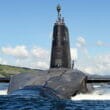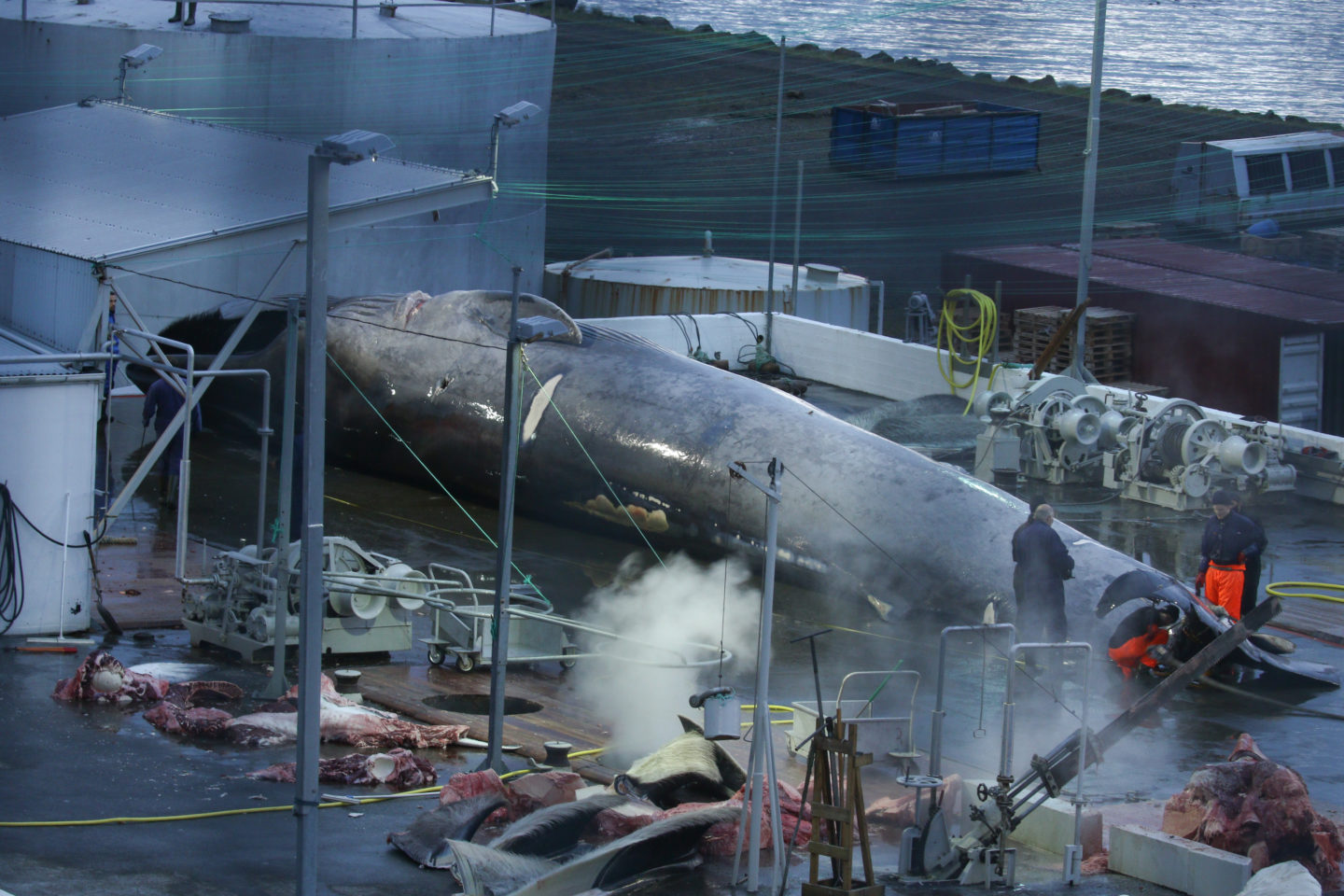A Scottish animal rights charity has criticised an Icelandic whaler after activists released footage that they claim shows the killing of the first endangered blue whale in 50 years.
Volunteers with Sea Shepherd have been monitoring the Hvalur hf whaling station in Hvalfjordur, Iceland, for several weeks and claimed yesterday to have evidence that a blue whale was killed and butchered on the 7 July.
Kristján Loftsson, who runs a commercial whaling company, denied the allegations and said the whale in question was a “hybrid whale”.
The blue whale is the largest animal known to have existed but during the 20th century the species was almost exterminated due to commercial whaling.
The population has slowly recovered following a global whaling ban but it remains endangered and faces a number of serious threats including ship strikes and the impact of climate change.
Releasing video footage and photos, Sea Shepherd claimed they reveal the slaughter of a blue whale. The group said it was the “22nd endangered whale killed and butchered for export to Japan” by Loftsson’s company since 20 June 2018.
Sea Shepherd UK said that the first 21 whales killed were “endangered fin whales” which the Icelandic government has permitted Loftsson’s company to slaughter, despite an international moratorium on whaling. But people are not permitted to kill blue whales, even within Iceland.
No other nations – including Japan and Norway – slaughter fin whales, Sea Shepherd added, claiming there has not been a blue whale harpooned for the last fifty years.
Sarah Moyes, of the Scottish animal welfare charity, OneKind, said that they were, “deeply concerned by the shocking news.”
The International Whaling Commission has outlawed all commercial whaling activities and both blue whales and fin whales are protected by the Convention on International Trade in Endangered Species.
Photographs and video taken by Sea Shepherd’s team near the whaling station made it possible, activists said, to “examine the species identifying indicators of skin colour/pattern, baleen colour, dorsal fin shape, and tail stock”.
Sea Shepherd UK said that Loftsson’s whaling station crew posed for photos next to – and on top of the whale – indicating “they knew very well this was a rare blue whale”.
“Then Loftsson ordered his crew to butcher the whale just like it was another fin whale – the meat, skin, blubber and bone all now mixed in with the fin whales previously caught, which will make it difficult or impossible to locate during potential inspections by the authorities,” a statement added.
Sea Shepherd Founder, Captain Paul Watson, said: “I have viewed plenty of blue whales on the surface, dived with them beneath the surface in West Australia, off the coast of California, in the Southern Ocean and in the waters off Newfoundland. I know a blue whale when I see one and this whale slaughtered by Kristján Loftsson is a blue whale.”
Watson is appealing to the Icelandic authorities to stop Loftsson from killing more whales. “This man must be stopped from ruthlessly violating international conservation law and bringing such disrepute to the nation of Iceland. There can be no legal justification for this crime,” he said.
Sea Shepherd UK’s chief operating officer Robert Read said: “The crime committed against this iconic whale must be fully investigated by independent inspectors with DNA samples taken from all the whale meat and parts in storage at Loftsson’s whaling station and warehouses.
“In addition, environmental DNA samples should be taken from whaling station equipment, surfaces and containers to look for blue whale DNA in case the butchered parts have been removed to hide this latest atrocity.”
Dr Phillip Clapham, of the US NOAA Alaska Fisheries Science Centre, said: “While I can’t entirely rule out the possibility that this is a hybrid, I don’t see any characteristics that would suggest that.
“From the photos, it has all the characteristics of a blue whale. Given that – notably the colouration pattern – there is almost no possibility that an experienced observer would have misidentified it as anything else at sea.”
In reply, Loftsson denied he had acted illegally. “This whale was not a blue whale, absolutely not. It was a hybrid and we’ve had at least five of these whales in the past that look similar,” he told The Ferret.
“It’s a hybrid between a blue and a fin. When you see the whales swimming in the ocean, it is like a fin whale, with a fin on its back, and other characteristics. When you have shot it, and you have it alongside the boat, then you see it is not typical like other fin whales.
“We have white colour with some black stripes on it. When you are out whaling and you see the animal in the ocean, it is a fin whale, but when you shoot it you see it is not a typical fin whale. The testicles in this male whale weighed about three kilos each.
“In a fin whale of this size they should be nine-10 kilos each. This was not a blue whale because blue whales are blue all over the body. We see them all the time and know exactly what they look like. This is not the first time this has happened and it’s important to realise it’s a hybrid, so it was not illegal.”
Sea Shepherd has had a crew on the ground in Iceland since the slaughter of fin whales began on 20 June. The aim is to document every whale killed during the fin whaling season.
Moyes from OneKind, said: “We’re deeply concerned by the shocking news that a blue whale has been cruelly slaughtered by the Hvalur hf whaling station in Iceland. It is especially tragic given this was the first blue whale to be harpooned in fifty years.
“There is no justification at all for killing an endangered species, and it’s clear work needs to be done to ensure other blue whales are not at risk of slaughter by Icelandic whalers in the future.”
Iceland’s Government said: “Regarding recent news that a blue whale may have been caught in Icelandic waters, it is important to note that blue whales are protected under Icelandic law with their capture prohibited. The matter is taken seriously by the government and the relevant authorities are investigating this issue.
“At present, we are not in a position to confirm the species, although initial information from the Directorate of Fisheries in Iceland suggests the animal caught is not likely to be a blue whale but rather a hybrid of a fin whale and a blue whale. This will only be confirmed once a DNA analysis has been concluded.
“Ensuring living marine resources are used responsibly and sustainably is of great importance to the Icelandic Government, and we are committed to protect our natural resources as they are essential in guaranteeing the long-term prosperity of our country.
“Whaling in Icelandic waters is only permitted in line with strict regulations for abundant whale stocks; the North Atlantic common minke whales and fin whales. This policy is science-based, sustainable, strictly managed and in accordance with international law.”
Blue whales range in length from 24 to 30 metres The largest ever recorded was 33.5 m long, according to the environmental group WWF, and females are up to 10 metres longer than males.
They can weigh up to 200 tonnes – in comparison, an adult male African elephant weighs around six tonnes.
Blue whales are the loudest animals on earth and their calls are louder than a jet engine. They can reach 188 decibels, while the noise from a jet engine can hit 140 decibels.














